Article I (11-122)
C6-4 General Central Commercial District
Establishment of the Special Downtown Brooklyn District
In order to carry out the special purposes of this Resolution as
set forth in Article X, Chapter 1, the #Special Downtown Brooklyn
District# is hereby established.
Article 1 (11-22)
Applications of Overlapping Regulations
Whenever any provision of this Resolution and any other
provisions of law, whether set forth in this Resolution or in any
other law, ordinance or resolution of any kind, impose
overlapping or contradictory regulations over the #use# of land,
or over the #use# or #bulk# of #buildings or other structures#,
or contain any restrictions covering any of the same subject
matter, that provision which is more restrictive or imposes
higher standards or requirements shall govern. In case of any
conflict between the performance standards and the rules and
regulations adopted by the Department of Environmental
Protection, the more restrictive shall apply.
Article 1 (12-10)
Arcade (2/2/11)
An “arcade” is a continuous covered space fronting on and open to
a #street# or #publicly accessible open area#, provided in
accordance with the provisions set forth in Section 37-80.
Base plane (10/9/13)
The “base plane” is a plane from which the height of a #building
or other structure# is measured as specified in certain Sections.
For #buildings#, portions of #buildings# with #street walls# at
least 15 feet in width, or #building segments# within 100 feet of
a #street line#, the level of the #base plane# is any level
between #curb level# and #street wall line level#. Beyond 100
feet of a #street line#, the level of the #base plane# is the
average elevation of the final grade adjoining the #building# or
#building segment#, determined in the manner prescribed by the
Building Code of the City of New York for adjoining grade
elevation. In either case, in the #flood zone#, either the #base
flood elevation# may be the level of the #base plane# or
#building# height may be measured from the #flood-resistant
construction elevation#, as provided in Article VI, Chapter 4.
For the purposes of this definition, #abutting buildings# on a
single #zoning lot# may be considered a single #building#. In
addition, the following regulations shall apply:
(a) Within 100 feet of a #street line#:
(1) The level of the #base plane# for a #building# or
#building segment# without a #street wall# shall be
determined by the average elevation of the final grade
adjoining such #building# or #building segment#.
(2) Where a #base plane# other than #curb level# is
established, the average elevation of the final grade
adjoining the #street wall# of the #building# or
#building segment#, excluding the entrance to a garage within the #street wall#, shall not be lower than the
level of the #base plane#, unless the #base plane# is
also the #base flood elevation#.
(3) Where the average elevation of the final grade
adjoining the #street wall# of the #building#,
excluding the entrance to a garage within the #street
wall#, is more than two feet below #curb level#, the
level of the #base plane# shall be the elevation of
such final grade, unless the #base plane# is also the
#base flood elevation#. This paragraph shall not apply
to #buildings developed# before June 30, 1989 in R2X,
R3, R4 or R5 Districts. Furthermore, this paragraph
shall not apply to #buildings# in C1 or C2 Districts
mapped within R2X, R3, R4 or R5 Districts, or in C3 or
C4-1 Districts, unless such #buildings# are located on
#waterfront blocks#.
(4) As an option, on sites which slope from the #street
wall line level# to the #rear wall line level# by at
least ten percent to the horizontal, the level of the
#base plane# may extend in a sloping plane from such
#street wall line level# to such #rear wall line
level#. When a sloping #base plane# is thus
established, the average elevation of the final grade
at the #rear wall line# shall not be lower than the
#rear wall line level#.
(b) For all #buildings#, where #base planes# of different
elevations apply to different portions of a #building#, only
that portion of the #building# to which such #base plane#
applies may be used to determine such #base plane#.
(c) For #buildings# located partially within and partially
beyond 100 feet of a #street line#, or where #corner lot# or
#through lot# regulations subject different portions of a
#building# to #base planes# of different elevations,
separate #base planes# may be determined for each such
portion of the #building# or, as an option, the elevation of
each such #base plane# may be multiplied by the percentage
of the total #lot coverage# of the #building# to which such
#base plane# applies. The sum of the products thus obtained
may be the elevation of the adjusted #base plane# applicable
to such #building#.
Commercial (2/2/11)
A “commercial” #use# is any #use# listed in Use Groups 5, 6, 7,
8, 9, 10, 11, 12, 13, 14, 15 or 16.
Commercial building (12/15/61)
A “commercial building” is a #building# used only for a
#commercial use#.
Commercial District (2/2/11)
A “Commercial District” includes any district whose designation
begins with the letter “C.”
For example, a “C4 District” includes any district whose
designation begins with the symbol “C4.”
Community facility (2/2/11)
A “community facility” #use# is any #use# listed in Use Group 3
or 4.
Community facility building (12/15/61)
A “community facility building” is a #building# used only for a
#community facility use#.
Floor area ratio (2/2/11)
“Floor area ratio” is the total #floor area# on a #zoning lot#,
divided by the #lot area# of that #zoning lot#. If two or more
#buildings# are located on the same #zoning lot#, the #floor area
ratio# is the sum of their #floor areas# divided by the #lot
area#. (For example, a #zoning lot# of 10,000 square feet with a
#building# containing 20,000 square feet of #floor area# has a
#floor area ratio# of 2.0, and a #zoning lot# of 20,000 square
feet with two #buildings# containing a total of 40,000 square
feet of #floor area# also has a #floor area ratio# of 2.0)
Plaza, public (2/2/11)
A “public plaza” is an open area for public use provided in
accordance with the requirements set forth in Section 37-70,
inclusive.
Sky exposure plane, rear (4/18/65)
A “rear sky exposure plane” is an imaginary inclined plane:
(a) beginning above a line at a distance from and parallel to
the #street line# and at a height set forth in the district
regulations; and
(b) rising over a #zoning lot# at a ratio of vertical distance
to horizontal distance set forth in the district
regulations.
Special Downtown Brooklyn District (2/2/11)
The “Special Downtown Brooklyn District” is a Special Purpose
District designated by the letters “DB” in which special
regulations set forth in Article X, Chapter 1, apply.
Street, narrow (12/15/61)
A “narrow street” is any #street# less than 75 feet wide.
Street, wide (12/19/11)
A “wide street” is any #street# 75 feet or more in width. In C5-
3, C6-4 or C6-6 Districts, when a #front lot line# of a #zoning
lot# adjoins a portion of a #street# whose average width is 75
feet or more and whose minimum width is 65 feet, such portion of
a #street# may be considered a #wide street#; or when a #front
lot line# adjoins a portion of a #street# 70 feet or more in
width, which is between two portions of a #street# 75 feet or
more in width, and which portion is less than 700 feet in length,
such portion may be considered a #wide street#, and in that case,
for the purposes of the height and setback regulations and the
measurement of any #publicly accessible open area# or #arcade#,
the #street line# shall be considered to be a continuous line
connecting the respective #street lines# of the nearest portions
of the #street# which are 75 feet or more in width.
Yard (9/19/73)
A “yard” is that portion of a #zoning lot# extending open and
unobstructed from the lowest level to the sky along the entire
length of a #lot line#, and from the #lot line# for a depth or
width set forth in the applicable district #yard# regulations.
Where a #street setback line# is shown on the City Map the #yard#
extends along the entire length of the #street setback line#, and
from the #street setback line# for a depth or width set forth in
the applicable district #yard# regulations.
Article III (32-00)
Use groups permitted for General Central Commercial C6 include use groups 1 through 11.
Article II (22-13)
R1 R2 R3 R4 R5 R6 R7 R8 R9 R10
Use Group 3 consists of community facilities that:
(1) may appropriately be located in #residential# areas to serve
educational needs or to provide other essential services for
the residents; or
(2)can perform their activities more effectively in a
#residential# environment, unaffected by objectionable
influences from adjacent industrial or general service
#uses#; and
(2) do not create significant objectionable influences in #residential# areas.
A. #Community facilities#
Colleges or universities
1, including professional schools
but excluding business colleges or trade schools
College or school student dormitories and fraternity or
sorority student houses
1 Domiciliary care facilities for adults
2,3 under the jurisdiction of the New York State Board of Social Welfare
which have secured certification by such agency
Libraries, museums or non-commercial art galleries
Monasteries, convents or novitiates, without restrictions as
to use for living purposes or location in relation to other
#uses# #Non-profit hospital staff dwellings# located on the same
#zoning lot# as the non-profit or voluntary hospital
and related facilities or on a separate #zoning lot# that is
immediately contiguous thereto or would be contiguous but
for its separation by a #street# or a #street# intersection
Nursing homes and health-related facilities
3 as defined in Section 10 NYCRR 700.2(a)
of the New York State Hospital Code, each of which have secured certification by the
appropriate governmental agency.
Nursing homes and health-related facilities are not permitted
within the boundaries of any Community District in which one or
more of the conditions set forth in Section 22-42 (Certification of Certain Community Facility Uses) applies except by special permit as set forth in Section 74-90
Philanthropic or non-profit institutions with sleeping accommodations
4 Sanitariums
3 #Schools#
B. #Accessory uses#
_______
1 Not permitted in
R1 or R2 Districts as-of-right
2 Permitted only by special permit by the City Planning
Commission pursuant to Section 74-903
3 Nursing homes, health related facilities, domiciliary care
facilities for adults and sanitariums that are proprietary
facilities are not permitted in R1 or R2 Districts
4 The number of persons employed in central office functions
shall not exceed 50, and the amount of #floor area# used for
such purposes shall not exceed 25 percent of the total #floor area#,
or, in R8, R9 or R10 Districts, 25,000 square feet, whichever is greater
Article III (32-41)
Enclosure within Buildings
C1 C2 C3 C4 C5 C6 C8
In the districts indicated, except as otherwise specifically
provided in the Use Groups permitted in such districts and in
Sections 36-11 (General Provisions), 36-61 (Permitted Accessory
Off-Street Loading Berths) and 73-36 (Physical Culture or Health
Establishments), all permitted #uses# which are created by
#development#, or which are #enlarged# or #extended#, or which
result from a change of #use# shall be subject to the provisions
of this Section with respect to enclosure within #buildings#.
With respect to the #enlargement# or #extension# of an existing
#use#, such provisions shall apply to the #enlarged# or #extended# portion of such #use#.
Article III (32-412)
In other Commercial Districts
C2 C3 C4 C6-1 C6-2 C6-3 C6-4 C6-6 C6-8 C6-9 C8
In the districts indicated, all such #uses# shall be located
within #completely enclosed buildings# or within #buildings#
which are #completely enclosed# except for store fronts or store
windows which may be opened to serve customers outside the
#building#.
Article III (32-45)
Certification of Certain Community Facility Uses
C1 C2 C3 C4 C5 C6
In all districts, as indicated, for any nursing homes and health-related facilities or #enlargement#, #extension# or change in #use# thereof, the City Planning Commission shall certify to the
Department of Buildings ,prior to the filing of any plans by the applicant for a building permit for such #use#,that none of the following conditions applies to the Community District within
which such #use#, or #enlargement#, #extension# or change in such
#use#,is to be located:
(1)the ratio between the number of beds for such #uses# in
existence, under construction or approved toward construction by the appropriate Federal or State governmental agency, to the population of the Community District compared to such ratio for other
Community Districts shows a relative concentration of facilities covered in this Section in the affected district;
(2) a scarcity of land for general community purposes exists; or
(3) the incidence of construction of facilities for the last three years warrants review over these facilities because they threaten to disrupt the land use balance in the community.
If the Commission finds that one or more of the conditions set forth in this Section applies to the Community District within which such #use#, or #enlargement#, #extension# or change in such
#use#, is to be located, a special permit pursuant to Section 74-90 shall be required.
Article III (33-12)
Maximum Floor Area Ratio
C1 C2 C3 C4 C5 C6 C7 C8
In all districts, as indicated, for any #zoning lot#, the maximum#floor area ratio# shall not exceed the #floor area ratio# set forth in this Section, except as otherwise provided in the following Sections:
Section 33-13
(Floor Area Bonus for a Public Plaza)
Section 33-14
(Floor Area Bonus for Arcades)
Section 33-15
(Floor Area Bonus for Front Yards)
Section 33-16
(Special Provisions for Zoning Lots Divided by District Boundaries)
Any given #lot area# shall be counted only once in determining
the #floor area ratio#. Except where authorized by express provisions of this Resolution,
the maximum #floor area ratio# shall not exceed the amount set forth in this Section by more than 20 percent.
In addition, the following limitations on maximum permitted #floor area# shall apply:
C1-8A C1-8X C1-9A C2-7A C2-7X C2-8A C4-6A C4-7A C5-1A C5-2A C6-2A C6-3A C6-3D C6-3X C6-4A
(a)
In contextual Commercial Districts
In the districts indicated, and in C1 and C2 Districts
mapped within R9A, R9D, R9X, R10A or R10X Districts, no
#floor area# bonuses are permitted.
(b)
In Community Board 7, Borough of Manhattan
Within the boundaries of
Community Board 7 in Manhattan,
in R10 equivalent #Commercial Districts# without a lettersuffix, the maximum #floor area ratio# shall not exceed 10.0.
(c)
In C6-1A Districts
In C6-1A Districts, the maximum #floor area ratio# shall not exceed the amount set forth in this Section by more than 50 percent.
(d)
In C6-4X Districts
In C6-4X Districts, a #floor area# bonus shall only be permitted for a #public plaza# pursuant to Section 33-13.
Article III (33-123)
Community facility buildings or buildings used for both community facility and commercial uses in all other Commercial Districts
C1-6 C1-7 C1-8 C1-9 C2-6 C2-7 C2-8 C3 C4 C5 C6 C8
In the districts indicated, the maximum #floor area ratio# for a #zoning lot# containing #community facility uses#, or for a #zoning lot# containing both #commercial# and #community facility uses#, shall not exceed the #floor area ratio# set forth in the following table:
Article III (33-13)
Floor Area Bonus For a Public Plaza
C4-6 C4-7 C5-1 C5-2 C5-3 C5-4 C6-1 C6-2 C6-3 C6-4 C6-5 C6-6 C6-7 C6-8 C6-9
(c)
#Zoning lots# containing #community facility uses# or both #commercial# and #community facility uses#
In the districts indicated, for #zoning lots# containing only #community facility uses# or both #commercial# and #community facility uses#, for each square foot of #public plaza# provided in accordance with Section 37-70, inclusive,the total #floor area# permitted on that #zoning lot# under the provisions of Section 33-12 may be increased as set forth in the following table:
Article III (33-14)
Floor Area Bonus For Public Arcades
C1-8 C1-9 C2-7 C2-8 C4-6 C4-7 C5 C6
(b)
In the districts indicated, and in C1 or C2 Districts when mapped within an R9 or R10 District, for
#zoning lots# containing #community facility uses#,
for each square foot of #arcade# provided on a #zoning lot# in accordance with
the provisions of Section 37-80, the total #floor area# permitted on that #zoning lot# under the provisions of Section 33-12 for a #zoning lot# containing only #community facility uses# or both #commercial# and #community facility uses# may be increased as set forth in the following table:
Article III (33-22)
Level of Yards
In all #Commercial Districts#, the level of a #yard# or of a #rear yard equivalent# shall not be higher than #curb level#.
However, this Section shall not be construed to require that natural grade level be disturbed in order to comply with this requirement.
No #building or other structure# shall be erected above ground level in any required #yard# or #rear yard equivalent# except as otherwise provided in Section 33-23 (Permitted Obstructions in Required Yards or Rear Yard Equivalents).
Article III (33-23)
Permitted Obstructions in Required Yards or Rear Yard Equivalents
In all #Commercial Districts#, the following obstructions shall be permitted when located within a required #yard# or #rear yard equivalent#:
(a)
In any #yard# or #rear yard equivalent#:
(1)
Arbors or trellises;
(2)
Awnings and other sun control devices, provided that when located at a level higher than the first #story#, excluding a #basement#, all such awnings and other sun control devices:
(i)
shall be limited to a maximum projection from a #building# wall of 2 feet, 6 inches; and
(ii)
shall have solid surfaces that, in aggregate, cover an area no more than 30 percent of the area of the #building# wall (as viewed in elevation) from which they project;
(3)
Canopies;
(4)
Chimneys, projecting not more than three feet into, and not exceeding two percent of the area of, the required #yard# or #rear yard equivalent#;
(5)
Eaves, gutters or downspouts, projecting into such #yard# or #rear yard equivalent# not more than 16
inches or 20 percent of the width of such #yard# or #rear yard equivalent#, whichever is the lesser distance;
(6)
Exterior wall thickness, where such wall thickness is added to the exterior face of a #building# wall existing on April 30, 2012, provided the added wall thickness has a thermal resistance (R-value) of at least 1.5 per inch, and is limited to one inch of thickness for every foot of existing #yard# width, up to a maximum thickness of eight inches. When an open area is provided along a common #lot line#, then such exterior wall thickness is limited to one inch for every foot of existing open area on the #zoning lot#;Where #buildings# that have added exterior wall thickness pursuant to this Section are #enlarged#, such #enlarged# portion may similarly encroach upon required #yards# in order to align with the exterior walls of the existing #building#, provided such #enlargement# contains less #floor area# than the existing #building#, and there is no encroachment of #floor area# into a required #yard#;
(7)
Fences;
(8)
Flagpoles;
(9)
Parking spaces for automobiles or bicycles, off-street, open, #accessory#;
(10)
Solar energy systems on walls existing on April 30, 2012, projecting no more than 10 inches and occupying no more than 20 percent of the surface area of the #building# wall (as viewed in elevation) from which it projects;
(11)
Steps, and ramps for people with disabilities;
(12)
Terraces or porches, open;
(13)
Walls, not exceeding eight feet in height and not roofed or part of a #building#.
(b)
In any #rear yard# or #rear yard equivalent#:
(1)
Balconies, unenclosed, subject to the provisions of Section 24-165;
(2)
Breezeways;
(3)
Any #building# or portion of a #building# used for any permitted #use# other than #residences#, except that any portion of a #building# containing rooms used for living or sleeping purposes (other than a room in a hospital used for the care or treatment of patients) shall not be a permitted obstruction, and provided that the height of such #building# shall not exceed one #story#, excluding #basement#, nor in any event 23 feet above #curb level#.
In addition, decks, parapet walls, roof thickness, skylights, vegetated roofs,and weirs,pursuant to Section 33-42 (Permitted Obstructions), shall be permitted above such a #building#, or portion thereof;
(4)
Fire escapes;
(5)
Parking spacesfor automobiles or bicycles, off-street, #accessory#,provided that the height of an #accessory building# used for such purposes and located in a required #rear yard# or #rear yard equivalent# shall not exceed 23 feet above #curb level#.
In addition, decks, parapet walls, roof thickness, skylights,vegetated roofs,and weirs, as set forth in Section 33-42, shall be permitted above such an #accessory building#, or portion thereof;
(6)
Solar energy systems:
(i)
on the roof of a #building# permitted as an obstruction to such #yard#, up to four feet in height as measured perpendicular to the roof surface when located above a permitted #commercial# or #community facility use# or attached parking structure;
(ii)
on the roof of a #building# permitted as an obstruction to such #yard#, shall be limited to 18 inches in height as measured perpendicular to the roof surface when located above a shed or detached parking structure, or on any roof with a slope greater than 20 degrees;
(iii)
on walls existing on April 30, 2012, projecting no more than 10 inches and occupying no more than 20 percent of the surface area of the #building# wall (as viewed in elevation) from which it projects;
(7)
Water-conserving devices required in connection with air conditioning or refrigeration systems in #buildings# existing prior to May 20, 1966, if located not less than 8 feet from any #lot line#.
However, no portion of a #rear yard equivalent# that is also a required #front yard# or required #side yard# may contain any obstructions not permitted in such #front yard# or #side yard#.
Article III (33-24)
Measurement of Yard Width or Depth In all #Commercial Districts#, the width or depth of a #yard# or #rear yard equivalent# shall be measured perpendicular to #lot lines#.
Article III (33-25)
Minimum Required Side Yards
C1 C2 C3 C4 C5 C6 C7 C8
In all districts, as indicated, no #side yards# are required. However, if an open area extending along a #side lot line# is provided at any level, it shall be either:
(a)
at least eight feet wide at every point; or
(b)
at least five feet wide at every point, with an average width of eight feet, such average being the mean of the width of the open area at its narrowest point and its width at its widest point, provided that:
(1)
such widest point shall be on a #street line#;
(2)
no portion of a #building# shall project beyond a straight line connecting such two points; and
(3)
in the case of a #zoning lot# bounded by a #side lot line# extending from #street# to #street#, such average shall be computed and such open area shall be provided as though each half of such #side lot line# bounded a separate #zoning lot#. Permitted obstructions pursuant to paragraph (a) of Section 33-23(Permitted Obstructions in Required Yards or Rear Yard Equivalents), shall be permitted in such open areas.
Article III (33-25)
Minimum Required Side Yards
C1 C2 C3 C4 C5 C6 C7 C8
In all districts, as indicated, no #side yards# are required.
However, if an open area extending along a #side lot line# is
provided at any level, it shall be either:
(a) at least eight feet wide at every point; or
(b) at least five feet wide at every point, with an average
width of eight feet, such average being the mean of the
width of the open area at its narrowest point and its width at its widest point, provided that:
(1) such widest point shall be on a #street line#;
(2) no portion of a #building# shall project beyond a
straight line connecting such two points; and
(3) in the case of a #zoning lot# bounded by a #side lot
line# extending from #street# to #street#, such average
shall be computed and such open area shall be provided
as though each half of such #side lot line# bounded a
separate #zoning lot#.
Permitted obstructions pursuant to paragraph (a) of Section 33-23
(Permitted Obstructions in Required Yards or Rear Yard
Equivalents), shall be permitted in such open areas.
Article III (33-26)
Minimum Required Rear Yards
C1 C2 C3 C4 C5 C6 C7 C8
In all districts, as indicated, a #rear yard# with a depth of not
less than 20 feet shall be provided at every #rear lot line# on
any #zoning lot# except as otherwise provided in Sections 33-27
(Special Provisions for Shallow Interior Lots), 33-28 (Special
Provisions for Through Lots) or 33-30 (OTHER SPECIAL PROVISIONS
FOR REAR YARDS). #Rear yards# shall also be provided along
portions of #side lot lines# as set forth in Section 33-261
(Beyond one hundred feet of a street line).
Article III (33-261)
Beyond one hundred feet of a street line
C1 C2 C3 C4 C5 C6 C7 C8
In all districts, as indicated, for #corner lots#, and for
#zoning lots# that are bounded by two or more #streets# that are
neither #corner lots# or #through lots#, the portion of a #side
lot line# beyond 100 feet of the #street line# that it intersects
shall be considered a #rear lot line# and a #rear yard# with a
minimum depth of 20 feet shall be provided where such #rear lot line# coincides with a #rear lot line# of an adjoining #zoning
lot#.
Article III (33-30)
OTHER SPECIAL PROVISIONS FOR REAR YARDS
C1 C2 C3 C4 C5 C6 C7 C8
In all districts, as indicated, the #rear yard# requirements set
forth in Section 33-26 (Minimum Required Rear Yards) shall be
modified as set forth in this Section.
Article III (33-301)
Within one hundred feet of corners
C1 C2 C3 C4 C5 C6 C7 C8
In all districts, as indicated, no #rear yard# shall be required
within 100 feet of the point of intersection of two #street
lines# intersecting at an angle of 135 degrees or less.
Article III (33-302)
Along short dimension of block
C1 C2 C3 C4 C5 C6 C7 C8In all districts, as indicated, whenever a #front lot line# of a
#zoning lot# coincides with all or part of a #street line#
measuring less than 230 feet in length between two intersecting
#streets#, no #rear yard# shall be required within 100 feet of
such #front lot line#.
Article III (33-303)
For zoning lots with multiple rear lot lines
C1 C2 C3 C4 C5 C6 C7 C8
In all districts, as indicated, for #zoning lots# with multiple
#rear lot lines#, if a #rear yard# extends from a #rear lot line#
away from the #street line# which is used to determine such #rear
lot line#, the following rules shall apply:(a) A #rear yard# with a minimum depth of 20 feet shall be
provided where such #rear lot line# coincides with a #rear
lot line# of an adjoining #zoning lot#.
(b) No #rear yard# shall be required where such #rear lot line#
coincides with a #side lot line# of an adjoining #zoning
lot#.
(c) For portions of #through lots# that have multiple #rear lot
lines# and such portions are not subject to #interior lot#
regulations, the #street line# bounding the #zoning lot#
closest to such #rear lot line# shall be used to determine
compliance with this Section.
Article III (33-40)
HEIGHT AND SETBACK REGULATIONS
Article III (33-42)
Permitted Obstructions
In all #Commercial Districts#, the following obstructions shall
be permitted and may thus penetrate a maximum height limit or
#sky exposure planes#, as set forth in Sections 33-43 (Maximum
Height of Walls and Required Setbacks), 33-44 (Alternate Front
Setbacks) or 33-491 (Limited Height Districts):
(a) Awnings and other sun control devices, provided that when
located at a level higher than the first #story#, excluding
a #basement#, all such awnings and other sun control
devices:(1) shall be limited to a maximum projection from a
#building# wall of 2 feet, 6 inches, except when
located on the first #story# above a setback;
(2) shall have solid surfaces that, in aggregate, cover an
area no more than 30 percent of the area of the
#building# wall (as viewed in elevation) from which
they project; and
(3) may rise above the permitted #building# height, up to
the height of a parapet wall or guardrail permitted in
accordance with Section 33-42 (Permitted Obstructions).
When located on the first #story# above a setback, awnings
and other sun control devices shall be limited to a
projection of 50 percent of the depth of the required
setback, and shall be limited, in total, to 50 percent of
the width of the #building# wall from which they project;
(b) Balconies, unenclosed, subject to the provisions of Section
24-166;
(c) #Building# columns, having an aggregate width equal to not
more than 20 percent of the #aggregate width of street
walls# of a #building#, to a depth not exceeding 12 inches,
in an #initial setback distance#, optional front open area,
or any other required setback distance or open area set
forth in Sections 33-43, 33-44 or 33-45 (Tower Regulations);
(d) Chimneys or flues, with a total width not exceeding 10
percent of the #aggregate width of street walls# of a
#building# at any given level;
(e) Decks, and other surfaces for recreational activities, not
more than 3 feet, 6 inches in height, as measured from the
maximum height limit, or the finished level of the roof as
it existed on April 30, 2012, whichever is higher;
(f) Elevator or stair bulkheads (including shafts; and
vestibules not larger than 60 square feet in area providing
access to a roof), roof water tanks and #accessory#
mechanical equipment (including enclosures), other than
solar or wind energy systems, provided that:
(1) such obstructions shall be located not less than 10
feet from the #street wall# of a #building#, except
that such obstructions need not be set back more than
25 feet from a #narrow street line# or more than 20
feet from a #wide street line#. However, such
restrictions on location shall not apply to elevator or stair bulkheads (including shafts or vestibules),
provided the #aggregate width of street walls# of such
bulkheads within 10 feet of a #street wall#, facing
each #street# frontage, times their average height, in
feet, does not exceed an area equal to four times the
width, in feet, of the #street wall# of the #building#
facing such frontage;
(2) all mechanical equipment shall be screened on all
sides;
(3) such obstructions and screening are contained within a
volume that complies with one of the following:
(i) the product, in square feet, of the #aggregate
width of street walls# of such obstructions facing
each #street# frontage, times their average
height, shall not exceed an area equal to eight
times the width, in feet, of the #street wall# of
the #building# facing such frontage; or
(ii) the #lot coverage# of all such obstructions does
not exceed 20 percent of the #lot coverage# of the
#building#, and where the maximum permitted height
of a #building# is less than 120 feet, such
obstructions are limited to a maximum height of
25 feet, and where the maximum permitted height
of a #building# is 120 feet or greater, such
obstructions are limited to a maximum height of 40
feet.
For the purposes of this paragraph, (f), #abutting
buildings# on a single #zoning lot# may be considered to be
a single #building#;
(g) Exterior wall thickness, up to eight inches, where such wall
thickness is added to the exterior face of a #building# wall
existing on April 30, 2012, provided the added wall
thickness has a thermal resistance (R-value) of at least 1.5
per inch. Where #buildings# that have added exterior wall
thickness pursuant to this Section are #enlarged#, such
#enlarged# portion may similarly penetrate a maximum height
limit in order to align with the exterior walls of the
existing #building#, provided such #enlargement# contains
less #floor area# than the existing #building#, and there is
no penetration of #floor area# above a maximum height limit;
(h) Flagpoles or aerials;
(i) House of worship towers, ornamental, having no #floor area# in portion of tower penetrating such height limit or #sky
exposure plane#;
(j) Parapet walls, not more than four feet in height, as
measured from the maximum height limit, or the finished
level of the roof as it existed on April 30, 2012, whichever
is higher. A guardrail with a surface at least 70 percent
open or with an opacity of not more than 30 percent (as
viewed in elevation), shall be permitted above a parapet
wall or within two feet of a parapet wall, provided such
guardrail is not more than four feet above the accessible
level of a roof. Such restriction on guardrail height shall
not apply when located beyond two feet from a parapet wall;
(k) Roof thickness, up to eight inches, to accommodate the
addition of insulation, for #buildings# or portions of
#buildings# constructed prior to April 30, 2012. For a
#building# that has added roof thickness pursuant to this
paragraph, an #enlargement# may align with the finished roof
surface of such #building#, provided the #enlarged# portion
does not exceed the maximum height limit by more than eight
inches;
(l) Rooftop greenhouses, permitted pursuant to Section 75-01
(Certification for Rooftop Greenhouses);
(m) Skylights, clerestories or other daylighting devices, not
more than four feet in height, as measured from the maximum
height limit, or the finished level of the roof as it
existed on April 30, 2012, whichever is higher. Such devices
shall be limited to a #lot coverage# not greater than 10
percent of the #lot coverage# of the roof and be located at
least eight feet from the #street wall# edge. However, such
devices shall not be permitted obstructions above a roof
with a slope greater than 20 degrees;
(n) Solar energy systems:
(1) on the roof of a #building#, up to four feet in height,
as measured from the maximum height limit, or the
finished level of the roof, whichever is higher;
(2) on the roof of a #building#, greater than four feet in
height, as measured from the maximum height limit, or
the finished level of the roof, whichever is higher,
provided that all such portions above four feet are set
back at least six feet from a #street wall#, limited to
a #lot coverage# not greater than 25 percent of the
#lot coverage# of the roof and do not exceed:
(i) in #Commercial Districts# mapped within #Residence
Districts#, and in C3 and C4-1 Districts, a height
of six feet;
(ii) in all other #Commercial Districts#, a height of
15 feet; and
(iii) when located on a bulkhead or other obstruction
pursuant to paragraph (f) of this Section, a
height of six feet;
(3) on walls existing on April 30, 2012, projecting no more
than 10 inches and occupying no more than 20 percent of
the surface area of the #building# wall (as viewed in
elevation) from which it projects.
However, any installation on a roof with a slope greater
than 20 degrees shall be limited to 18 inches in height, as
measured perpendicular to the roof surface;
(o) Spires or belfries;
(p) Vegetated roofs, not more than 3 feet, 6 inches in height,
excluding vegetation, as measured from the maximum height
limit, or the finished level of the roof as it existed on
April 30, 2012, whichever is higher. On roofs with slopes
greater than 20 degrees, vegetated roofs shall be limited to
a height of 12 inches measured perpendicular to such roof
surface;
(q) Weirs, check dams and other equipment for stormwater
management, not more than 3 feet, 6 inches in height, as
measured from the maximum height limit, or the finished
level of the roof as it existed on April 30, 2012, whichever
is higher;
(r) Wind energy systems on portions of #buildings# with a height
of 100 feet or greater, provided that:
(1) the highest point of the wind turbine assembly is closer than
10 feet to any #lot line#; and
(3) may rise above the permitted #building# height, up to
the height of a parapet wall or guardrail permitted in
accordance with Section 33-42 (Permitted Obstructions).
When located on the first #story# above a setback, awnings
and other sun control devices shall be limited to a
projection of 50 percent of the depth of the required
setback, and shall be limited, in total, to 50 percent of
the width of the #building# wall from which they project;
(b) Balconies, unenclosed, subject to the provisions of Section
24-166;
(c) #Building# columns, having an aggregate width equal to not
more than 20 percent of the #aggregate width of street
walls# of a #building#, to a depth not exceeding 12 inches,
in an #initial setback distance#, optional front open area,
or any other required setback distance or open area set
forth in Sections 33-43, 33-44 or 33-45 (Tower Regulations);
(d) Chimneys or flues, with a total width not exceeding 10
percent of the #aggregate width of street walls# of a
#building# at any given level;
(e) Decks, and other surfaces for recreational activities, not
more than 3 feet, 6 inches in height, as measured from the
maximum height limit, or the finished level of the roof as
it existed on April 30, 2012, whichever is higher;
(f) Elevator or stair bulkheads (including shafts; and
vestibules not larger than 60 square feet in area providing
access to a roof), roof water tanks and #accessory#
mechanical equipment (including enclosures), other than
solar or wind energy systems, provided that:
(1) such obstructions shall be located not less than 10
feet from the #street wall# of a #building#, except
that such obstructions need not be set back more than
25 feet from a #narrow street line# or more than 20
feet from a #wide street line#. However, such
restrictions on location shall not apply to elevator or
stair bulkheads (including shafts or vestibules),
provided the #aggregate width of street walls# of such
bulkheads within 10 feet of a #street wall#, facing
each #street# frontage, times their average height, in
feet, does not exceed an area equal to four times the
width, in feet, of the #street wall# of the #building#
facing such frontage;
(2) all mechanical equipment shall be screened on all
sides;
(3) such obstructions and screening are contained within a
volume that complies with one of the following:
(i) the product, in square feet, of the #aggregate
width of street walls# of such obstructions facing
each #street# frontage, times their average
height, shall not exceed an area equal to eight
times the width, in feet, of the #street wall# of
the #building# facing such frontage; or
(ii) the #lot coverage# of all such obstructions does
not exceed 20 percent of the #lot coverage# of the
#building#, and where the maximum permitted height
of a #building# is less than 120 feet, such
obstructions are limited to a maximum height of
25 feet, and where the maximum permitted height
of a #building# is 120 feet or greater, such
obstructions are limited to a maximum height of 40
feet.
For the purposes of this paragraph, (f), #abutting
buildings# on a single #zoning lot# may be considered to be
a single #building#;
(g) Exterior wall thickness, up to eight inches, where such wall
thickness is added to the exterior face of a #building# wall
existing on April 30, 2012, provided the added wall
thickness has a thermal resistance (R-value) of at least 1.5
per inch. Where #buildings# that have added exterior wall
thickness pursuant to this Section are #enlarged#, such
#enlarged# portion may similarly penetrate a maximum height
limit in order to align with the exterior walls of the
existing #building#, provided such #enlargement# contains
less #floor area# than the existing #building#, and there is
no penetration of #floor area# above a maximum height limit;
(h) Flagpoles or aerials;
(i) House of worship towers, ornamental, having no #floor area#
exposure plane#;
(j) Parapet walls, not more than four feet in height, as
measured from the maximum height limit, or the finished
level of the roof as it existed on April 30, 2012, whichever
is higher. A guardrail with a surface at least 70 percent
open or with an opacity of not more than 30 percent (as
viewed in elevation), shall be permitted above a parapet
wall or within two feet of a parapet wall, provided such
guardrail is not more than four feet above the accessible
level of a roof. Such restriction on guardrail height shall
not apply when located beyond two feet from a parapet wall;
(k) Roof thickness, up to eight inches, to accommodate the
addition of insulation, for #buildings# or portions of
#buildings# constructed prior to April 30, 2012. For a
#building# that has added roof thickness pursuant to this
paragraph, an #enlargement# may align with the finished roof
surface of such #building#, provided the #enlarged# portion
does not exceed the maximum height limit by more than eight
inches;
(l) Rooftop greenhouses, permitted pursuant to Section 75-01
(Certification for Rooftop Greenhouses);
(m) Skylights, clerestories or other daylighting devices, not
more than four feet in height, as measured from the maximum
height limit, or the finished level of the roof as it
existed on April 30, 2012, whichever is higher. Such devices
shall be limited to a #lot coverage# not greater than 10
percent of the #lot coverage# of the roof and be located at
least eight feet from the #street wall# edge. However, such
devices shall not be permitted obstructions above a roof
with a slope greater than 20 degrees;
(n) Solar energy systems:
(1) on the roof of a #building#, up to four feet in height,
as measured from the maximum height limit, or the
finished level of the roof, whichever is higher;
(2) on the roof of a #building#, greater than four feet in
height, as measured from the maximum height limit, or
the finished level of the roof, whichever is higher,
provided that all such portions above four feet are set
back at least six feet from a #street wall#, limited to
a #lot coverage# not greater than 25 percent of the
#lot coverage# of the roof and do not exceed:
(i) in #Commercial Districts# mapped within #Residence
Districts#, and in C3 and C4-1 Districts, a height
of six feet;
(ii) in all other #Commercial Districts#, a height of
15 feet; and
(iii) when located on a bulkhead or other obstruction
pursuant to paragraph (f) of this Section, a
height of six feet;
(3) on walls existing on April 30, 2012, projecting no more
than 10 inches and occupying no more than 20 percent of
the surface area of the #building# wall (as viewed in
elevation) from which it projects.
However, any installation on a roof with a slope greater
than 20 degrees shall be limited to 18 inches in height, as
measured perpendicular to the roof surface;
(o) Spires or belfries;
(p) Vegetated roofs, not more than 3 feet, 6 inches in height,
excluding vegetation, as measured from the maximum height
limit, or the finished level of the roof as it existed on
April 30, 2012, whichever is higher. On roofs with slopes
greater than 20 degrees, vegetated roofs shall be limited to
a height of 12 inches measured perpendicular to such roof
surface;
(q) Weirs, check dams and other equipment for stormwater
management, not more than 3 feet, 6 inches in height, as
measured from the maximum height limit, or the finished
level of the roof as it existed on April 30, 2012, whichever
is higher;
(r) Wind energy systems on portions of #buildings# with a height
of 100 feet or greater, provided that:
(1) the highest point of the wind turbine assembly does not
exceed 55 feet;
(2) no portion of the wind turbine assembly is closer than
10 feet to any #lot line#; and
(3) in districts where new #residences# or new #joint
living work quarters for artists# are allowed as-ofright
or by special permit or authorization, or within
100 feet of such districts, the diameter of the swept
area of the rotor does not exceed 15 feet;
(s) Window washing equipment mounted on a roof;
(t) Wire, chain link or other transparent fences.
(2/2/11)
Artile III (33-43)
Maximum Height of Walls and Required Setbacks
C1 C2 C3 C4 C5 C6 C7 C8
In all districts, as indicated, if the front wall or other
portion of a #building or other structure# is located at the
#street line# or within the #initial setback distance# set forth
in this Section, the height of such front wall or other portion
of a #building or other structure# shall not exceed the maximum
height above #curb level# set forth in this Section. Above such
specified maximum height and beyond the #initial setback
distance#, the #building or other structure# shall not penetrate
the #sky exposure plane# set forth in this Section. The
regulations of this Section shall apply except as otherwise
provided in Sections 33-42 (Permitted Obstructions), 33-44
(Alternate Front Setbacks), 33-45 (Tower Regulations), 33-49
(Special Height Limitations), inclusive, 74-85 (Height and
Setback Regulations for Residential Buildings) or 85-04
(Modifications of Bulk Regulations).
Article III (33-432)
In other Commercial Districts
C1-6 C1-7 C1-8 C1-9 C2-6 C2-7 C2-8 C3 C4 C5 C6 C7 C8
(a) In the districts indicated, the maximum height of a front
wall and the required front setback of a #building or other
structure#, except as otherwise set forth in this Section,
shall be as set forth in the following table:
Article III (33-44)
Alternate Front Setbacks
C1 C2 C3 C4 C5 C6 C7 C8
In all districts as indicated, if an open area is provided along
the full length of the #front lot line# with the minimum depth
set forth in this Section, the provisions of Section 33-43
(Maximum Height of Walls and Required Setbacks) shall not apply.
The minimum depth of such open area shall be measured
perpendicular to the #front lot line#. However, in such
instances, except as otherwise provided in Sections 33-42
(Permitted Obstructions), 33-45 (Tower Regulations) or 85-04
(Modifications of Bulk Regulations), no #building or other
structure# shall penetrate the alternate #sky exposure plane# set
forth in this Section, and the #sky exposure plane# shall be
measured from a point above the #street line#.
If the open area provided under the terms of this Section is a
#public plaza#, such open area may be counted for the bonus
provided for a #public plaza# in the districts indicated in
Section 33-13 (Floor Area Bonus for a Public Plaza).
Article III (33-442)
In other Commercial Districts
C1-6 C1-7 C1-8 C1-9 C2-6 C2-7 C2-8 C3 C4 C5 C6 C7 C8In the districts indicated, the alternate front setback
regulations applicable to a #building or other structure# shall
be as set forth in the following table:
Article III (33-45)
Tower Regulations
Article III (33-451)
In certain specified Commercial Districts
C4-7 C5-2 C5-3 C5-4 C5-5 C6-4 C6-5 C6-6 C6-7 C6-8 C6-9
In the districts indicated, any #buildings# or portions thereof
which in the aggregate occupy not more than 40 percent of the
#lot area# of a #zoning lot# or, for #zoning lots# of less than
20,000 square feet, the percent set forth in Section 33-454
(Towers on small lots), may penetrate an established #sky exposure plane#. (Such #building# or portion thereof is
hereinafter referred to as a tower.) At any given level, except
where the provisions set forth in Section 33-455 (Alternate
regulations for towers on lots bounded by two or more streets) or
33-456 (Alternate setback regulations on lots bounded by two or
more streets) or 33-457 (Tower setbacks on narrow blocks) are
applicable and where the option is taken to be governed by such
provisions, such tower may occupy any portion of the #zoning lot#
not located less than 15 feet from the #street line# of a #narrow
street#, or less than 10 feet from the #street line# of a #wide
street#, provided that the aggregate area so occupied within 50
feet of a #narrow street# shall not exceed 1,875 square feet and
the aggregate area so occupied within 40 feet of a #wide street#
shall not exceed 1,600 square feet.
If all of the #buildings# on a #zoning lot# containing such tower
do not occupy at any level more than the maximum percent of the
#lot area# set forth in this Section or Section 33-454 for
towers, the tower may occupy any portion of the #zoning lot#
located 20 feet or more from the #street line# of a #narrow
street# or 15 feet or more from the #street line# of a #wide
street#, provided that the aggregate area so occupied within 50
feet of a #narrow street# shall not exceed 2,250 square feet and
the aggregate area so occupied within 40 feet of a #wide street#
shall not exceed 2,000 square feet.
Unenclosed balconies, subject to the provisions of Section 24-165
(Balconies in R3 through R10 Districts), are permitted to project
into or over open areas not occupied by towers.
Article III (33-472)
Community facility uses
C1 C2 C3 C4 C5 C6 C7 C8
In all districts, as indicated, for certain #community facility
uses# in specified situations, the Board of Standards and Appeals
may modify the regulations set forth in Sections 33-41 to 33-45,
inclusive, relating to Height and Setback Regulations in
accordance with the provisions of Section 73-64 (Modifications
for Community Facility Uses)
Article VII (73-64)
Modifications for Community Facility Uses
On a #zoning lot# occupied by any of the #community facility
uses# specified in this Section, and in all districts where such
#uses# are permitted as-of-right or by special permit, the Board
of Standards and Appeals may permit #developments# or
#enlargements# for such #uses#, which do not comply with certain
applicable district #bulk# regulations, in accordance with the
provisions of this Section.
Such specified #community facility uses# are:
College or school student dormitories or fraternity and
sorority student houses
Colleges or universities, including professional schools,
but excluding business colleges or trade schools
Community centers
Houses of worship, rectories, parish houses or
seminaries
Libraries, museums or non-commercial art galleries
Monasteries, convents or novitiates
#Non-profit hospital staff dwellings#
Non-profit or voluntary hospitals and related facilities
Philanthropic or non-profit institutions with or without sleeping accommodations, excluding ambulatory diagnostic or
treatment health care facilities listed in Use Group 4
#Schools#
Article III (33-50)
COURT REGULATIONS AND MINIMUM DISTANCE BETWEEN WINDOWS AND WALLS
OR LOT LINES
Basic Regulations
Article III (33-51)
Minimum Dimensions of Courts for Community Facility Buildings
C1 C2 C3 C4 C5 C6 C8
In all districts, as indicated, the regulations set forth in the
following Sections shall apply to all #buildings# containing
#community facility uses#:
Section 24-61 (General Provisions and Applicability)
Section 24-62 (Minimum Dimensions of Courts)
Section 24-63 (Outer Court Regulations)
Section 24-64 (Inner Court Regulations)
Section 24-65 (Minimum Distance between Required Windows
and Walls or Lot Lines)
Section 24-66 (Modifications of Court Regulations or
Distance Requirements)
Section 24-67 (Special Provisions for Buildings Used Partly
for Residential Uses)Section 24-68 (Permitted Obstructions in Courts).
Article X (101-222)
Standard height and setback regulations
R7-1 C5-4 C6-1 C6-4
In the districts indicated, except C6-1A Districts, a
#building or other structure# shall not exceed the applicable
maximum #building# height set forth in the table in this
Section. Furthermore, any portion of a #building or other
structure# that exceeds the applicable maximum base height
shall be set back at least 10 feet from a #wide street line#
and at least 15 feet from a #narrow street line#.
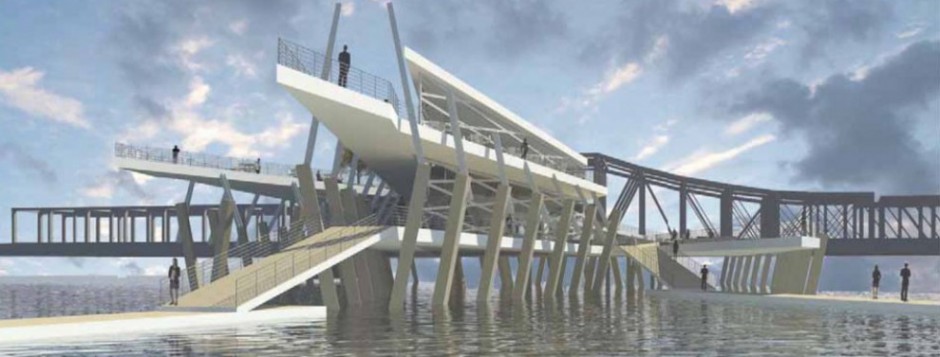
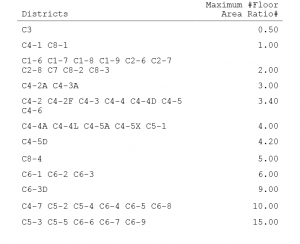
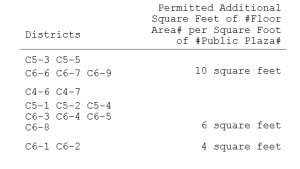
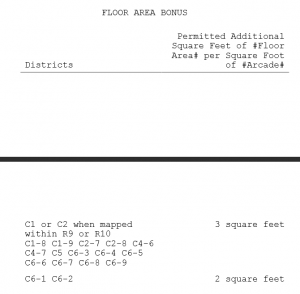
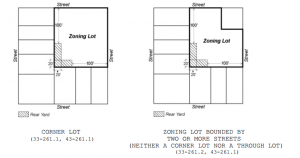

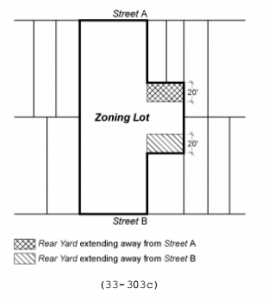
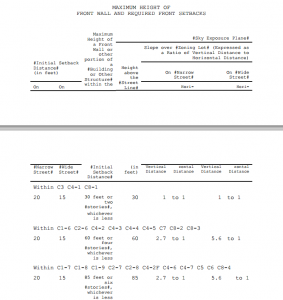
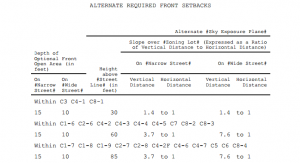
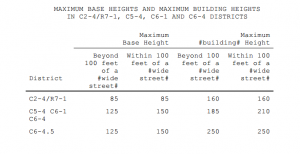



Article III (33-03)
Street Tree Planting in Commercial Districts
C1 C2 C3 C4 C5 C6 C7 C8
In all districts, as indicated, the following shall provide
#street# trees in accordance with Section 26-41 (Street Tree
Planting):
(a) #developments#, or #enlargements# that increase the #floor
area# on a #zoning lot# by 20 percent or more. However,
#street# trees shall not be required for #enlargements# of
#single-# or #two-family residences#, except as provided in
paragraphs (b) and (c) of this Section;
Article II (26-41)
Street Tree Planting
In accordance with applicability requirements of underlying
district regulations, one #street# tree, pre-existing or newly
planted, shall be provided for every 25 feet of #street# frontage
of the #zoning lot#. Fractions equal to or greater than one-half
resulting from this calculation shall be considered to be one
tree. Such trees shall be planted at approximately equal
intervals along the entire length of the curb of the #street#
adjacent to the #zoning lot#.